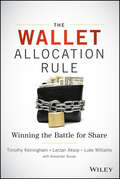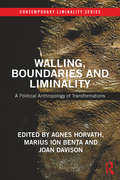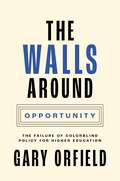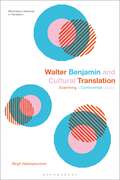- Table View
- List View
The Wallet Allocation Rule: Winning the Battle for Share
by Timothy L. Keiningham Lerzan Aksoy Luke Williams Alexander J. BuoyeCustomer Loyalty Isn't Enough—Grow Your Share of Wallet The Wallet Allocation Rule is a revolutionary, definitive guide for winning the battle for share of customers' hearts, minds, and wallets. Backed by rock-solid science published in the Harvard Business Review and MIT Sloan Management Review, this landmark book introduces a new and rigorously tested approach—the Wallet Allocation Rule—that is proven to link to the most important measure of customer loyalty: share of wallet. Companies currently spend billions of dollars each year measuring and managing metrics like customer satisfaction and Net Promoter Score (NPS) to improve customer loyalty. These metrics, however, have almost no correlation to share of wallet. As a result, the returns on investments designed to improve the customer experience are frequently near zero, even negative. With The Wallet Allocation Rule, managers finally have the missing link to business growth within their grasp—the ability to link their existing metrics to the share of spending that customers allocate to their brands. Learn why improving satisfaction (or NPS) does not improve share. Apply the Wallet Allocation Rule to discover what really drives customer spending. Uncover new metrics that really matter to achieve growth. By applying the Wallet Allocation Rule, managers get real insight into the money they currently get from their customers, the money available to be earned by them, and what it takes to get it. The Wallet Allocation Rule provides managers with a blueprint for sustainable long-term growth.
Walling, Boundaries and Liminality: A Political Anthropology of Transformations (Contemporary Liminality)
by Agnes Horvath, Marius Ion Benţa and Joan DavisonContemporary challenges related to walls, borders and encirclement, such as migration, integration and endemic historical conflicts, can only be understood properly from a long-term perspective. This book seeks to go beyond conventional definitions of the long durée by locating the social practice of walling and encirclement in the broadest context of human history, integrating insights from archaeology and anthropology. Such an approach, far from being simply academic, has crucial contemporary relevance, as its focus on origins helps to locate the essential dynamics of this practice, and provides a rare external position from which to view the phenomenon as a transformative exercise, with the area walled serving as an artificial womb or matrix. The modern world, with its ingrained ideas of borders, nation states and other entities, often makes it is very difficult to gain a critical distance and detachment to see beyond conventional perspectives. The unique approach of this book offers an antidote to this problem. Cases discussed in the book range from Palaeolithic caves, the ancient walls of Göbekli Tepe, Jericho and Babylon, to the foundation of Rome, the Chinese Empire, medieval Europe and the Berlin Wall. The book also looks at contemporary developments such as the Palestinian wall, Eastern and Southern European examples, Trump’s proposed Mexican wall, the use of Greece as a bulwark containing migration flows and the transformative experience of voluntary work in a Calcutta hospice. In doing so, the book offers a political anthropology of one of the most fundamental yet perennially problematic human practices: the constructing of walls. As such, it will appeal to scholars of sociology, anthropology and political theory.
Walling, Boundaries and Liminality: A Political Anthropology of Transformations (Contemporary Liminality)
by Agnes Horvath Marius Ion Benţ A Joan DavisonContemporary challenges related to walls, borders and encirclement, such as migration, integration and endemic historical conflicts, can only be understood properly from a long-term perspective. This book seeks to go beyond conventional definitions of the long durée by locating the social practice of walling and encirclement in the broadest context of human history, integrating insights from archaeology and anthropology. Such an approach, far from being simply academic, has crucial contemporary relevance, as its focus on origins helps to locate the essential dynamics of this practice, and provides a rare external position from which to view the phenomenon as a transformative exercise, with the area walled serving as an artificial womb or matrix. The modern world, with its ingrained ideas of borders, nation states and other entities, often makes it is very difficult to gain a critical distance and detachment to see beyond conventional perspectives. The unique approach of this book offers an antidote to this problem. Cases discussed in the book range from Palaeolithic caves, the ancient walls of Göbekli Tepe, Jericho and Babylon, to the foundation of Rome, the Chinese Empire, medieval Europe and the Berlin Wall. The book also looks at contemporary developments such as the Palestinian wall, Eastern and Southern European examples, Trump’s proposed Mexican wall, the use of Greece as a bulwark containing migration flows and the transformative experience of voluntary work in a Calcutta hospice. In doing so, the book offers a political anthropology of one of the most fundamental yet perennially problematic human practices: the constructing of walls. As such, it will appeal to scholars of sociology, anthropology and political theory.
The Walls around Opportunity: The Failure of Colorblind Policy for Higher Education (Our Compelling Interests #6)
by Gary OrfieldThe case for race-conscious education policyIn our unequal society, families of color fully share the dream of college but their children often attend schools that do not prepare them, and the higher education system gives the best opportunities to the most privileged. Students of color hope for college but often face a dead end.For many young people, racial inequality puts them at a disadvantage from early childhood. The Walls around Opportunity argues that colorblind policies have made college inaccessible to a large share of students of color, and reveals how policies that acknowledge racial inequalities and set racial equality goals can succeed where colorblindness has failed.Gary Orfield paints a troubling portrait of American higher education, explaining how profound racial gaps imbedded in virtually every stage of our children’s lives pose a major threat to communities of color and the nation. He describes how the 1960s and early 1970s was the only period in history to witness sustained efforts at racial equity in higher education, and how the Reagan era ushered in today’s colorblind policies, which ignore the realities of color inequality. Orfield shows how this misguided policy has resegregated public schools, exacerbated inequalities in college preparation, denied needed financial aid to families, and led to huge price increases over decades that have seen little real gain in income for most Americans.Drawing on a wealth of new data and featuring commentaries by Stella Flores and James Anderson, this timely and urgent book shows how colorblind policies serve only to raise the walls of segregation higher, and proposes real solutions that can make higher education available to all.
The Walls around Opportunity: The Failure of Colorblind Policy for Higher Education (Our Compelling Interests #8)
by Gary OrfieldThe case for race-conscious education policyIn our unequal society, families of color fully share the dream of college but their children often attend schools that do not prepare them, and the higher education system gives the best opportunities to the most privileged. Students of color hope for college but often face a dead end.For many young people, racial inequality puts them at a disadvantage from early childhood. The Walls around Opportunity argues that colorblind policies have made college inaccessible to a large share of students of color, and reveals how policies that acknowledge racial inequalities and set racial equality goals can succeed where colorblindness has failed.Gary Orfield paints a troubling portrait of American higher education, explaining how profound racial gaps imbedded in virtually every stage of our children&’s lives pose a major threat to communities of color and the nation. He describes how the 1960s and early 1970s was the only period in history to witness sustained efforts at racial equity in higher education, and how the Reagan era ushered in today&’s colorblind policies, which ignore the realities of color inequality. Orfield shows how this misguided policy has resegregated public schools, exacerbated inequalities in college preparation, denied needed financial aid to families, and led to huge price increases over decades that have seen little real gain in income for most Americans.Now with a new afterword that discusses the 2023 Supreme Court decision to outlaw affirmative action in college admissions, this timely and urgent book shows that the court&’s colorblind ruling is unworkable in a society where every aspect of opportunity and preparation is linked to race, and reveals the gaps in the opportunity pipeline while exploring the best ways to address them in light of this decision.
Walls, Borders, Boundaries: Spatial and Cultural Practices in Europe (Spektrum: Publications of the German Studies Association #4)
by Marc Silberman Karen E. Till Janet WardHow is it that walls, borders, boundaries—and their material and symbolic architectures of division and exclusion—engender their very opposite? This edited volume explores the crossings, permeations, and constructions of cultural and political borders between peoples and territories, examining how walls, borders, and boundaries signify both interdependence and contact within sites of conflict and separation. Topics addressed range from the geopolitics of Europe’s historical and contemporary city walls to conceptual reflections on the intersection of human rights and separating walls, the memory politics generated in historically disputed border areas, theatrical explorations of border crossings, and the mapping of boundaries within migrant communities.
Walls, Borders, Boundaries: Spatial and Cultural Practices in Europe (Spektrum: Publications of the German Studies Association #4)
by Marc Silberman Karen E. Till Janet WardHow is it that walls, borders, boundaries—and their material and symbolic architectures of division and exclusion—engender their very opposite? This edited volume explores the crossings, permeations, and constructions of cultural and political borders between peoples and territories, examining how walls, borders, and boundaries signify both interdependence and contact within sites of conflict and separation. Topics addressed range from the geopolitics of Europe’s historical and contemporary city walls to conceptual reflections on the intersection of human rights and separating walls, the memory politics generated in historically disputed border areas, theatrical explorations of border crossings, and the mapping of boundaries within migrant communities.
Walls of Indifference: Immigration and the Militarization of the Us-Mexico Border
by Nicole I TorresThis ethnography documents and explores the social, political, and material consequences of militarization in the borderlands of Arizona. Based on two years of fieldwork in Phoenix, Tucson, and other communities along the US-Mexico border, the author identifies militarization as a social and political phenomenon that gradually reconfigures both individuals and communities. Through ethnographic instances, she explores how the vocabularies of race, nationalism, and patriotism decrease political engagement and simultaneously increase conflict within the borderland communities.
Walls of Indifference: Immigration and the Militarization of the Us-Mexico Border
by Nicole I TorresThis ethnography documents and explores the social, political, and material consequences of militarization in the borderlands of Arizona. Based on two years of fieldwork in Phoenix, Tucson, and other communities along the US-Mexico border, the author identifies militarization as a social and political phenomenon that gradually reconfigures both individuals and communities. Through ethnographic instances, she explores how the vocabularies of race, nationalism, and patriotism decrease political engagement and simultaneously increase conflict within the borderland communities.
Walls That Remain: Eastern and Western Germans Since Reunification
by John RoddenThe Walls That Remain explores the trauma of German reunification in 1990 as it affected ordinary Eastern and Western Germans. Told mainly in their own words, this book features the voices of those Germans who have suffered as well as profited from the transformations in German society since the fall of the Berlin Wall in 1989 and Germany's reunification in October 1990.
Walls That Remain: Eastern and Western Germans Since Reunification
by John RoddenThe Walls That Remain explores the trauma of German reunification in 1990 as it affected ordinary Eastern and Western Germans. Told mainly in their own words, this book features the voices of those Germans who have suffered as well as profited from the transformations in German society since the fall of the Berlin Wall in 1989 and Germany's reunification in October 1990.
Walter Benjamin: The Colour of Experience
by Howard CaygillThis book analyses the development of Benjamin's concept of experience in his early writings showing that it emerges from an engagement with visual experience, and in particular the experience of colour.
Walter Benjamin: The Colour of Experience
by Howard CaygillThis book analyses the development of Benjamin's concept of experience in his early writings showing that it emerges from an engagement with visual experience, and in particular the experience of colour.
Walter Benjamin: The Colour of Experience
by Howard CaygillThis book analyzes the development of Walter Benjamin's concept of experience in his early writings showing that it emerges from an engagement with visual experience, and in particular the experience of colour. It represents Benjamin as primarily a thinker of the visual field.
Walter Benjamin: The Colour of Experience
by Howard CaygillThis book analyzes the development of Walter Benjamin's concept of experience in his early writings showing that it emerges from an engagement with visual experience, and in particular the experience of colour. It represents Benjamin as primarily a thinker of the visual field.
Walter Benjamin and Cultural Translation: Examining a Controversial Legacy (Bloomsbury Advances in Translation)
by Birgit HaberpeuntnerDissecting the radical impact of Walter Benjamin on contemporary cultural, postcolonial and translation theory, this book investigates the translation and reception of Benjamin's most famous text about translation, “The Task of the Translator,” in English language debates around 'cultural translation'. For years now, there has been a pronounced interest in translation throughout the Humanities, which has come with an increasing detachment of translation from linguistic-textual parameters. It has generated a broad spectrum of discussions subsumed under the heading of 'cultural translation', a concept that is constantly re-invented and manifests in often heavily diverging expressions. However, there seems to be a distinct constant: In their own (re-)formulations of this concept, a remarkable number of scholars-Bhabha, Chow, Niranjana, to name but a few-explicitly refer to Walter Benjamin's “The Task of the Translator.” In its first part, this book considers Benjamin and the way in which he thought about, theorized and practiced translation throughout his writings. In a second part, Walter Benjamin meets 'cultural translation': tracing various paths of translation and reception, this part also tackles the issues and debates that result from the omnipresence of Walter Benjamin in contemporary theories and discussions of 'cultural translation'. The result is a clearer picture of the translation and reception processes that have generated the immense impact of Benjamin on contemporary cultural theory, as well as new perspectives for a way of reading that re-shapes the canonized texts themselves and holds the potential of disturbing, shifting and enriching their more 'traditional' readings.
Walter Benjamin and Cultural Translation: Examining a Controversial Legacy (Bloomsbury Advances in Translation)
by Birgit HaberpeuntnerDissecting the radical impact of Walter Benjamin on contemporary cultural, postcolonial and translation theory, this book investigates the translation and reception of Benjamin's most famous text about translation, “The Task of the Translator,” in English language debates around 'cultural translation'. For years now, there has been a pronounced interest in translation throughout the Humanities, which has come with an increasing detachment of translation from linguistic-textual parameters. It has generated a broad spectrum of discussions subsumed under the heading of 'cultural translation', a concept that is constantly re-invented and manifests in often heavily diverging expressions. However, there seems to be a distinct constant: In their own (re-)formulations of this concept, a remarkable number of scholars-Bhabha, Chow, Niranjana, to name but a few-explicitly refer to Walter Benjamin's “The Task of the Translator.” In its first part, this book considers Benjamin and the way in which he thought about, theorized and practiced translation throughout his writings. In a second part, Walter Benjamin meets 'cultural translation': tracing various paths of translation and reception, this part also tackles the issues and debates that result from the omnipresence of Walter Benjamin in contemporary theories and discussions of 'cultural translation'. The result is a clearer picture of the translation and reception processes that have generated the immense impact of Benjamin on contemporary cultural theory, as well as new perspectives for a way of reading that re-shapes the canonized texts themselves and holds the potential of disturbing, shifting and enriching their more 'traditional' readings.
Walter Benjamin and the Aesthetics of Change
by A. M. PuscaFollowing the spirit of Benjamin's Arcades Project, this book acts as a kaleidoscope of change in the 21st century, tracing its different reflections in the international contemporary while seeking to understand individual/collective reactions to change through a series of creative methodologies.
Wandel der Governance der Erwerbsarbeit
by Irene Dingeldey André Holtrup Günter WarsewaUnter dem Leitbegriff „Governance von Arbeit“ analysieren die AutorInnen Veränderungen und Kontinuitäten in Bezug auf die Gestaltung von Arbeitsbedingungen und Karriereentwicklung, Entlohnung und Interessenvertretung, wie auch Institutionen der Reproduktion (Berufsbildung, Familie) in Deutschland. Übergreifende These ist, dass sich alte und neue Institutionen im Sinne veränderter Komplementaritäten verbinden und sowohl individuelle als auch kollektive Akteure veranlassen, z.T. neue, eigene Bewältigungs- und Entlastungsstrategien zu entwickeln. Die sozialen Folgen dieser Entwicklung werden als „bipolare Heterogenisierung“ skizziert, d.h. dass jenseits des traditionellen Kerns, der nach wie vor durch Normalarbeitsverhältnis, Normalbiographie und Normalfamilie geprägt ist, eine zunehmende Polarisierung der Arbeits- und Lebensbedingungen in Richtung Privilegierung und Prekarisierung zu erkennen ist.
Wandel ostdeutscher Familiengedächtnisse: Erinnerungen der „Vertreibung“ zwischen Nationalsozialismus, Wende und Gegenwart (Soziales Gedächtnis, Erinnern und Vergessen – Memory Studies)
by Katinka MeyerIn einer biographie- und erinnerungstheoretischen Untersuchung geht Katinka Meyer der Frage nach, wie ostdeutsche Familien an die „Vertreibung“ der Deutschen aus den ehemaligen Ostgebieten erinnern. Diese Familien waren durch ihre Ansiedlung in der SBZ/DDR mit einer antifaschistischen Erinnerungskultur konfrontiert. In der Studie wird empirisch das komplexe Zusammenspiel familieninterner Dynamiken und gesellschaftlicher Systemwechsel – von Nationalsozialismus, über die DDR bis zur Bundesrepublik – innerhalb der Familiengedächtnisse rekonstruiert. Auf individueller, intergenerationeller und familienbiographischer Ebene verdeutlicht sie, dass die Familiengeschichte dazu genutzt werden kann, Traumatisierungen zu bearbeiten, Verluste zu erinnern und NS-Täterschaft zu verschweigen.
Wandel und Reform deutscher Universitätsverwaltungen: Eine Organigrammanalyse (Organization & Public Management)
by Michael BorggräfeAm Beispiel deutscher Universitätsverwaltungen geht Michael Borggräfe der Frage nach, wie sich Organisationen auf der Basis ihrer Organigramme analysieren lassen. Der Autor entwickelt ein systematisches, regelgeleitetes und replizierbares Verfahren zur Analyse von Organigrammen, das sich sowohl auf qualitative als auch auf quantitative Methoden der empirischen Sozialforschung stützt. Dieser innovative Ansatz einer systematischen Organigrammanalyse liefert neue Einblicke in Veränderungen des Managements und der Administration deutscher Hochschulen. Das entwickelte Verfahren selbst bietet sowohl der Hochschul- als auch der Organisationsforschung potenzielle Anwendungsmöglichkeiten in weiteren organisationalen, nationalen und internationalen Kontexten und ist anschlussfähig für andere methodische Zugänge.
Wandel (v)erkennen: Shifting Baselines und die Wahrnehmung umweltrelevanter Veränderungen aus wissenssoziologischer Sicht
by Dietmar RostAngemessene Antworten auf die Problematik von Klimawandel und Artenschwund verlangen eine gesellschaftliche Wahrnehmung von langfristigen Veränderungen in Natur und Gesellschaft. Das Buch fragt nach den Formen, Grenzen und Konsequenzen der individuellen und kollektiven Wahrnehmung von Wandel und eröffnet ein wissenssoziologisch fundiertes Verständnis der (Nicht-)Wahrnehmung vergangener wie auch zukünftiger Veränderungsprozesse. Dies erfolgt zunächst in einer theoretischen Perspektive durch die Zusammenführung von relevanten Gesichtspunkten aus der Erinnerungs-, Generationen- und Zeitforschung. Das Konzept der „Shifting Baselines“ liefert hierfür einen Ausgangspunkt. Daran anschließend blickt das Buch anhand von Aufschlüssen aus qualitativen Interviews auf die Wahrnehmung von Wandlungsprozessen unterschiedlicher Dynamik – von langsamem, rapidem und krassem (d.h. katastrophischem) Wandel –, um schließlich die Frage der Varianz und historischen Veränderung der Wahrnehmung von Wandel zu diskutieren.
The Waning of the Mediterranean, 1550–1870: A Geohistorical Approach
by Faruk TabakConventional scholarship on the Mediterranean portrays the Inner Sea as a timeless entity with unchanging ecological and agrarian features. But, Faruk Tabak argues, some of the "traditional" and "olden" characteristics that we attribute to it today are actually products of relatively recent developments. Locating the shifting fortunes of Mediterranean city-states and empires in patterns of long-term economic and ecological change, this study shows how the quintessential properties of the basin—the trinity of cereals, tree crops, and small livestock—were reestablished as the Mediterranean's importance in global commerce, agriculture, and politics waned.Tabak narrates this history not from the vantage point of colossal empires, but from that of the mercantile republics that played a pivotal role as empire-building city-states. His unique juxtaposition of analyses of world economic developments that flowed from the decline of these city-states and the ecological change associated with the Little Ice Age depicts large-scale, long-term social change. Integrating the story of the western and eastern Mediterranean—from Genoa and the Habsburg empire to Venice and the Ottoman and Byzantine empires—Tabak unveils the complex process of devolution and regeneration that brought about the eclipse of the Mediterranean.

















